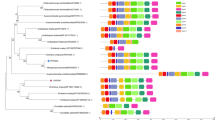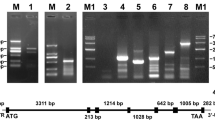Abstract
Carbonic anhydrases (CAs) play important roles in the utilization of inorganic carbon and have been studied in many higher plants and algae. Herein, based on unigene sequences from Pyropia haitanensis, six full-length CA of P. haitanensis (PhCA) genes were obtained by rapid amplification of complementary DNA (cDNA) ends, or by direct polymerase chain reaction (PCR), and named PhαCA1, PhαCA2, PhβCA1, PhβCA2, PhβCA3, and PhγCA1. The full-length cDNAs of the six PhCA genes comprised 1156, 1151, 1146, 847, 1124, and 1013 nucleotides, respectively. The encoded proteins were 275, 287, 206, 245, 307, and 290 amino acids, with isoelectric points of 10.26, 5.40, 6.03, 6.42, 7.66, and 4.75, respectively. On the basis of conserved motifs and phylogenetic tree analysis, the PhCAs were divided into three CA classes: PhαCA1 and PhαCA2 are α-CAs; PhβCA1, PhβCA2, and PhβCA3 are β-CAs; and PhγCA1 is a γ-CA. In different CO2 concentrations, the expression levels of PhβCA2, PhβCA3, and PhγCA1 showed no significant changes; however, the expression levels of PhαCA1, PhαCA2, and PhβCA1 decreased significantly under high CO2. The expression level of each PhβCA gene was significantly higher in the sporophytes than in the gametophytes; however, the expression levels of PhαCA and PhγCA in the sporophytes were significantly lower than those in the gametophytes. The expression level of each PhCA under desiccation and high-temperature stress had a different pattern. These results suggested that PhCAs play important roles in the utilization of inorganic carbon of P. haitanensis. Additionally, the expressions of PhCAs were significantly affected by environmental stresses.









Similar content being viewed by others
References
Ashraf M, Harris PJC (2013) Photosynthesis under stressful environments: an overview. Photosynthetica 51:163–190
Badger M (2003) The roles of carbonic anhydrases in photosynthetic CO2 concentrating mechanisms. Photosynth Res 77:83–94
Blouin NA, Brodie JA, Grossman AC, Xu P, Brawley SH (2011) Porphyra: a marine crop shaped by stress. Trends Plant Sci 16:29–37
Chen CS, Ji DH, Xie CT, Xu Y, Liang Y, Zhen YJ, Shi XZ, Wang FX, Zhao LM (2008) Preliminary study on selecting the high temperature resistance strains and economic traits of Porphyra haitanensis. Acta Oceanol Sin 30:100–106 (in Chinese with English abstract)
Eriksson M, Karlsson J, Ramazanov Z, Gardestrom P, Samuelsson G (1996) Discovery of an algal mitochondrial carbonic anhydrase: molecular cloning and characterization of a low-CO2-induced polypeptide in Chlamydomonas reinhardtii. Proc Natl Acad Sci U S A 93:12031–12034
Eriksson M, Villand P, Gardestrom P, Samuelsson G (1998) Induction and regulation of expression of a low-CO2-induced mitochondrial carbonic anhydrase in Chlamydomonas reinhardtii. Plant Physiol 116:637–641
Fabre N, Reiter IM, Becuwe-Linka N, Genty B, Rumeau D (2007) Characterization and expression analysis of genes encoding α and β carbonic anhydrases in Arabidopsis. Plant Cell Environ 30:617–629
Fan XL, Fang YJ, Hu SN, Wang GC (2007) Generation and analysis of 5318 expressed sequence tags from the filamentous sporophyte of Porphyra haitanensis (Rhodophyta). J Phycol 43:1287–1294
Ferry JG (2010) The γ class of carbonic anhydrases. Biochim Biophys Acta 1804:374–381
Karlsson J, Clarke AK, Chen ZY, Hugghins SY, Park YI, Husic HD, Moroney JV, Samuelsson G (1998) A novel a-type carbonic anhydrase associated with the thylakoid membrane in Chlamydomonas reinhardtii is required for growth at ambient CO2. EMBO J 17:1208–1216
Kisker C, Schindelin H, Alber BE, Ferry JG, Rees DC (1996) A left-handed beta-helix revealed by the crystal structure of a carbonic anhydrase from the archaeon Methanosarcina thermophila. EMBO J 15:2323–2330
Lee RBY, Smith JAC, Rickaby REM (2013) Cloning, expression and characterization of the δ-carbonic anhydrase of Thalassiosira weissflogii (Bacillariophyceae). J Phycol 49:170–177
Liu YC (2009) Mechanism for differential desiccation tolerance in Porphyra species. PhD Thesis, Northeastern University
Luo QJ, Pei LQ, Pan SY (2002) Utilization of inorganic carbon in free-living conchocelis of Porphyra haitanensis. J Fish 26:477–480 (in Chinese with English abstract)
Moroney JV, Husic HD, Tolbert NE (1985) Effect of carbonic anhydrase inhibitors on inorganic carbon accumulation by Chlamydomonas reinhardtii. Plant Physiol 79:177–183
Moroney JV, Bartlett SG, Samuelsson G (2001) Carbonic anhydrases in plants and algae. Plant Cell Environ 24:141–153
Moroney JV, Ma YB, Frey WD, Fusilier KA, Pham TT, Simms TA, DiMario RJ, Yang J, Mukherjee B (2011) The carbonic anhydrase isoforms of Chlamydomonas reinhardtii: intracellular location, expression, and physiological roles. Photosynth Res 109:133–149
Moskvin OV, Ivanov BN, Ignatova LK, Kollmeier MA (2000) Light-induced stimulation of carbonic anhydrase activity in pea thylakoids. FEBS Lett 470:375–377
Raven JA (2001) A role for mitochondrial carbonic anhydrase in limiting CO2 leakage from low CO2-grown cells of Chlamydomonas reinhardtii. Plant Cell Environ 24:261–265
Roberts SB, Lane TW, Morel FMM (1997) Carbonic anhydrase in the marine diatom Thalassiosira weissflogii (Bacillariophyceae). J Phycol 33:845–850
Sahoo D, Tang XR, Yarish C (2002) Porphyra-the economic seaweed as a new experimental system. Curr Sci 83:1313–1316
So AK, Espie GS (2005) Cyanobacterial carbonic anhydrases. Can J Bot 83:721–734
So AK, Espie GS, Williams EB, Shively JM, Heinhorst S, Cannon GC (2004) A novel evolutionary lineage of carbonic anhydrase (epsilon class) is a component of the carboxysome shell. J Bacteriol 186:623–630
Soto AR, Zheng H, Shoemaker D, Rodriguez J, Read BA, Wahlund TM (2006) Identification and preliminary characterization of two cDNAs encoding unique carbonic anhydrases from the marine alga Emiliania huxleyi. Appl Environ Microbiol 72:5500–5511
Tamura K, Peterson D, Peterson N, Stecher G, Nei M, Kumar S (2011) MEGA5: molecular evolutionary genetics analysis using maximum likelihood, evolutionary distance, and maximum parsimony methods. Mol Biol Evol 28:2731–2739
Tiwari A, Kumar P, Singh S, Ansari SA (2005) Carbonic anhydrase in relation to higher plants. Photosynthetica 43:1–11
Van K, Spalding MH (1999) Periplasmic carbonic anhydrase structural gene (Cah1) mutant in Chlamydomonas reinhardtii. Plant Physiol 120:757–764
Von Caemmerer S, Quinn V, Hancock NC, Price GD, Furbank RT, Ludwig M (2004) Carbonic anhydrase and C4 photosynthesis: a transgenic analysis. Plant Cell Environ 27:697–703
Wang SG, Yang R, Zhou XQ, Song DD, Sun X, Luo QJ (2013) Utilization of inorganic in Pyropia haitanensis (Rhodophyta) under heat stress. Oceanology Limnol Sin 44:1378–1385 (in Chinese with English abstract)
Xie C, Li B, Xu Y, Ji D, Chen C (2013) Characterization of the global transcriptome for Pyropia haitanensis (Bangiales, Rhodophyta) and development of cSSR markers. BMC Genomics 14:107
Xu Y, Chen CS, Ji DH, Hang N, Xie CT (2014) Proteomic profile analysis of Pyropia haitanensis in response to high-temperature stress. J Appl Phycol 26:607–618
Ye RX, Yu Z, Shi WW, Gao HJ, Bi HY, Zhou ZG (2014) Characterization of α-type carbonic anhydrase (CA) gene and subcellular localization of α-CA in the gametophytes of Saccharina japonica. J Appl Phycol 26:881–890
Yu S, Zhang XX, Guan QJ, Takano T, Liu SK (2007) Expression of a carbonic anhydrase gene is induced by environmental stresses in rice (Oryza sativa L.). Biotechnol Lett 29:89–94
Yu Z, Bi YH, Zhou ZG (2011) Cloning and characterization of carbonic anhydrase (CA) gene from Laminaria japonica gametophytes. J Fish China 35:1343–1353 (in Chinese with English abstract)
Zhang BY, Yang F, Wang GC, Peng G (2010) Cloning and quantitative analysis of the carbonic anhydrase gene from Porphyra yezoensis. J Phycol 46:290–296
Zou DH, Gao KS (2002a) Photosynthetic bicarbonate utilization in Porphyra haitanensis (Bangiales, Rhodophyta). Chin Sci Bull 47:1629–1633
Zou DH, Gao KS (2002b) Effects of desiccation and CO2 concentrations on emersed photosynthesis in Porphyra haitanensis (Bangiales, Rhodophyta), a species farmed in China. Eur J Phycol 37:587–592
Acknowledgments
This research was supported in part by the 863 Project of China (Grant No: 2012AA10A411), the National Natural Science Foundation of China (Grant Nos.: 41176151 and 41276177), and the National Marine Public Welfare Research Project (Grant Nos.: 201105008 and 201105023).
Author information
Authors and Affiliations
Corresponding author
Rights and permissions
About this article
Cite this article
Chen, C., Dai, Z., Xu, Y. et al. Cloning, expression, and characterization of carbonic anhydrase genes from Pyropia haitanensis (Bangiales, Rhodophyta). J Appl Phycol 28, 1403–1417 (2016). https://doi.org/10.1007/s10811-015-0646-x
Received:
Revised:
Accepted:
Published:
Issue Date:
DOI: https://doi.org/10.1007/s10811-015-0646-x




